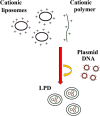A sight on the current nanoparticle-based gene delivery vectors
- PMID: 24936161
- PMCID: PMC4046008
- DOI: 10.1186/1556-276X-9-252
A sight on the current nanoparticle-based gene delivery vectors
Abstract
Nowadays, gene delivery for therapeutic objects is considered one of the most promising strategies to cure both the genetic and acquired diseases of human. The design of efficient gene delivery vectors possessing the high transfection efficiencies and low cytotoxicity is considered the major challenge for delivering a target gene to specific tissues or cells. On this base, the investigations on non-viral gene vectors with the ability to overcome physiological barriers are increasing. Among the non-viral vectors, nanoparticles showed remarkable properties regarding gene delivery such as the ability to target the specific tissue or cells, protect target gene against nuclease degradation, improve DNA stability, and increase the transformation efficiency or safety. This review attempts to represent a current nanoparticle based on its lipid, polymer, hybrid, and inorganic properties. Among them, hybrids, as efficient vectors, are utilized in gene delivery in terms of materials (synthetic or natural), design, and in vitro/in vivo transformation efficiency.
Keywords: Gene delivery; Inorganic vectors; Nanoparticles; Non-viral vectors.
Figures
Similar articles
-
Synthesis and application of poly(ethylene glycol)-co-poly(β-amino ester) copolymers for small cell lung cancer gene therapy.Acta Biomater. 2016 Sep 1;41:293-301. doi: 10.1016/j.actbio.2016.05.040. Epub 2016 Jun 1. Acta Biomater. 2016. PMID: 27262740 Free PMC article.
-
Mechanisms and challenges of nanocarriers as non-viral vectors of therapeutic genes for enhanced pulmonary delivery.J Control Release. 2022 Dec;352:970-993. doi: 10.1016/j.jconrel.2022.10.061. Epub 2022 Nov 16. J Control Release. 2022. PMID: 36372386 Free PMC article. Review.
-
Viral vector mimicking and nucleus targeted nanoparticles based on dexamethasone polyethylenimine nanoliposomes: Preparation and evaluation of transfection efficiency.Colloids Surf B Biointerfaces. 2018 May 1;165:252-261. doi: 10.1016/j.colsurfb.2018.02.043. Epub 2018 Feb 21. Colloids Surf B Biointerfaces. 2018. PMID: 29494955
-
Systematic comparison of nonviral gene delivery strategies for efficient co-expression of two transgenes in human mesenchymal stem cells.J Biol Eng. 2023 Dec 7;17(1):76. doi: 10.1186/s13036-023-00394-0. J Biol Eng. 2023. PMID: 38062439 Free PMC article.
-
Current state of the art in peptide-based gene delivery.J Control Release. 2022 Mar;343:600-619. doi: 10.1016/j.jconrel.2022.02.010. Epub 2022 Feb 11. J Control Release. 2022. PMID: 35157938 Review.
Cited by
-
Hybrid, metal oxide-peptide amphiphile micelles for molecular magnetic resonance imaging of atherosclerosis.J Nanobiotechnology. 2018 Nov 15;16(1):92. doi: 10.1186/s12951-018-0420-8. J Nanobiotechnology. 2018. PMID: 30442135 Free PMC article.
-
Non-Viral in Vitro Gene Delivery: It is Now Time to Set the Bar!Pharmaceutics. 2020 Feb 21;12(2):183. doi: 10.3390/pharmaceutics12020183. Pharmaceutics. 2020. PMID: 32098191 Free PMC article. Review.
-
Production and clinical development of nanoparticles for gene delivery.Mol Ther Methods Clin Dev. 2016 Apr 6;3:16023. doi: 10.1038/mtm.2016.23. eCollection 2016. Mol Ther Methods Clin Dev. 2016. PMID: 27088105 Free PMC article. Review.
-
Nanomedicine delivers promising treatments for rheumatoid arthritis.Nanomedicine (Lond). 2015;10(13):2063-74. doi: 10.2217/nnm.15.45. Epub 2015 Jun 18. Nanomedicine (Lond). 2015. PMID: 26084368 Free PMC article. Review.
-
Magnetic Nanoparticle Assisted Self-assembly of Cell Penetrating Peptides-Oligonucleotides Complexes for Gene Delivery.Sci Rep. 2017 Aug 22;7(1):9159. doi: 10.1038/s41598-017-09803-z. Sci Rep. 2017. PMID: 28831162 Free PMC article.
References
-
- Pouton CW, Seymour LW. Key issues in non-viral gene delivery. Adv Drug Deliv Rev. 2001;9(1–3):187–203. - PubMed
-
- Hendriks WT, Ruitenberg MJ, Blits B, Boer GJ, Verhaagen J. Viral vector-mediated gene transfer of neurotrophins to promote regeneration of the injured spinal cord. Prog Brain Res. 2004;9:451–476. - PubMed
LinkOut - more resources
Full Text Sources
Other Literature Sources



